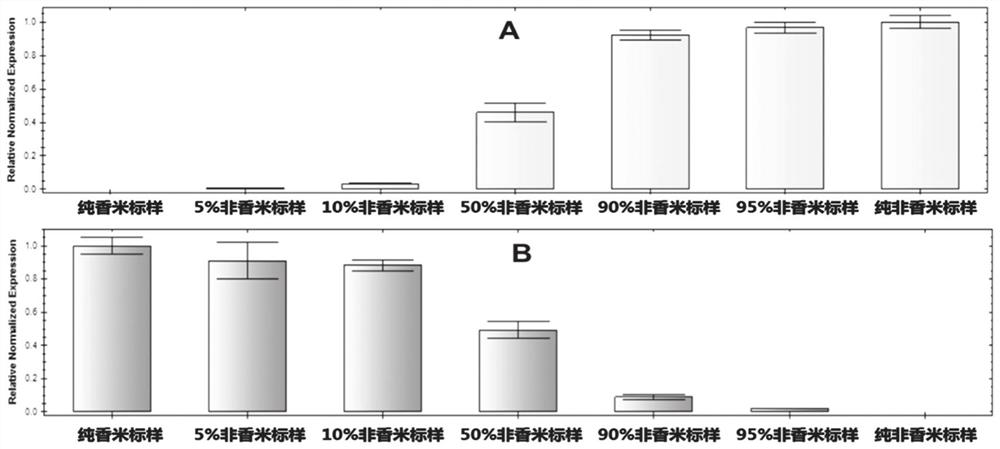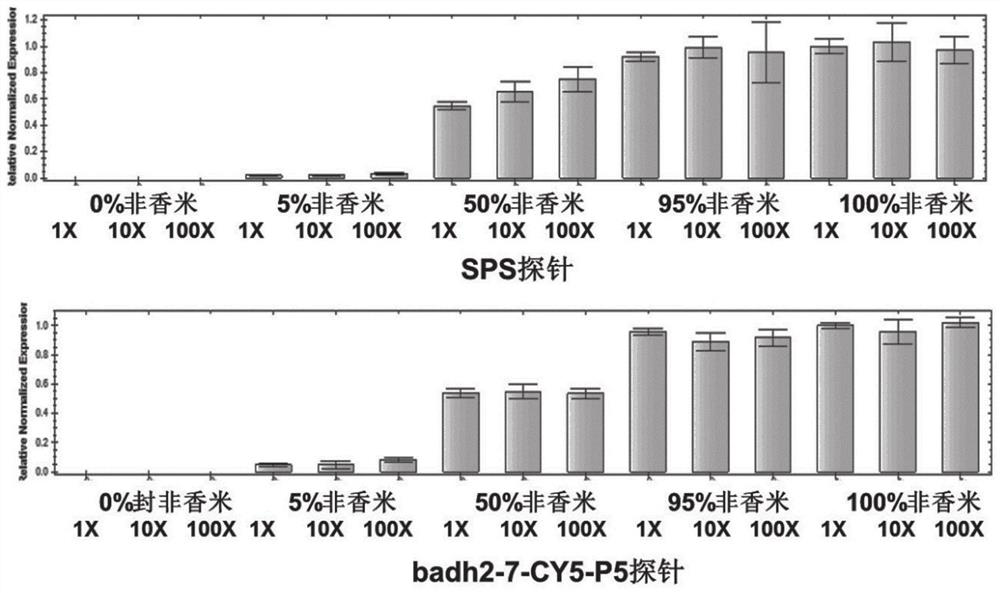Quantitative detection method for purity of fragrant rice based on molecular biology and detection kit thereof
A quantitative detection and kit technology, which is used in the determination/inspection of microorganisms, biochemical equipment and methods, DNA/RNA fragments, etc., can solve the problems of poor accuracy and difficulty in quantitative detection of fragrant rice content, and avoid human judgment. , The results are intuitive and objective, and the operation is convenient and fast.
- Summary
- Abstract
- Description
- Claims
- Application Information
AI Technical Summary
Problems solved by technology
Method used
Image
Examples
Embodiment 1
[0065] Example 1: Materials and methods
[0066] 1. Materials
[0067] The seeds and rice samples of different fragrant and non-fragrant rice varieties were purchased from the market.
[0068] 2. Enzymes and Reagents
[0069] The enzymes were purchased from Kangwei Century Company and Bio-Rad Company, the reagents were purchased from Sinopharm Chemical Reagent Co., Ltd., and the fluorescent quantitative PCR instrument Bio-Rad CFX96; the primers and probes used in the experiment were synthesized by Shanghai Sangon Bioengineering Company .
[0070] 3. Experimental method
[0071] 3.1 DNA extraction from rice seeds (rice samples)
[0072] Take 20 grams of rice seeds (rice samples), grind them with a grinder, weigh 50 mg of powder into a 2 mL sample lysis tube, add 500 μL of Buffer 1, vortex for 30 seconds, incubate at 52°C for 30 minutes, and rotate at 1200 rpm; Add 500 μL of Buffer 2, vortex and mix for 30 seconds, centrifuge the mixture for 5 minutes (12000 rpm), absorb 50...
Embodiment 2
[0091] Example 2: Real-time fluorescent quantitative PCR detection of non-fragrant rice and fragrant rice
[0092] Using the extracted DNA as a template, primers badh2-7-LF1 and badh2-7-LR1, non-fragrant rice-specific probe badh2-7-22MGB-P, fragrant rice-specific probe badh2-7-VIC-P4, and The endogenous reference probe badh2-7-CY5-P5 was detected by real-time fluorescent PCR. The PCR reaction system is 20 μL, including 10 μL of 2×GoldStar Best MasterMix, 1.5 μL of badh2-7-LF1 primer (concentration of 10 μM), and 1.5 μL of badh2-7-LR1 primer (concentration of 10 μM), badh2-7-22MGB-P Probe, badh2-7-VIC-P4 probe and badh2-7-CY5-P5 probe (concentration: 10 μM) were 0.25 μL each, template DNA was 2 μL, and sterile water was added to 20 μL. In the blank control, sterile water was used instead of template DNA. Each reaction was repeated three times, and the PCR amplification program used a two-step method: pre-denaturation at 95°C for 10 min; denaturation at 95°C for 15 s; annealin...
Embodiment 3
[0095] Example 3: Analysis of quantitative detection data of different internal reference genes
[0096]Using the extracted DNA as a template, primers badh2-7-LF1 and badh2-7-LR1, non-fragrant rice-specific probe badh2-7-22MGB-P, fragrant rice-specific probe badh2-7-VIC-P4, and internal The source reference probe badh2-7-CY5-P5 was detected by real-time fluorescent PCR. The PCR reaction system is 20 μL, including 10 μL of 2×GoldStar Best MasterMix, 1.5 μL of badh2-7-LF1 primer (concentration of 10 μM), and 1.5 μL of badh2-7-LR1 primer (concentration of 10 μM), badh2-7-22MGB-P Probe, badh2-7-VIC-P4 probe and badh2-7-CY5-P5 probe (concentration: 10 μM) were 0.25 μL each, template DNA was 2 μL, and sterile water was added to 20 μL. In the blank control, sterile water was used instead of template DNA. Each reaction was repeated three times, and the PCR amplification program used a two-step method: pre-denaturation at 95°C for 10 min; denaturation at 95°C for 15 s; annealing and ...
PUM
 Login to View More
Login to View More Abstract
Description
Claims
Application Information
 Login to View More
Login to View More - R&D
- Intellectual Property
- Life Sciences
- Materials
- Tech Scout
- Unparalleled Data Quality
- Higher Quality Content
- 60% Fewer Hallucinations
Browse by: Latest US Patents, China's latest patents, Technical Efficacy Thesaurus, Application Domain, Technology Topic, Popular Technical Reports.
© 2025 PatSnap. All rights reserved.Legal|Privacy policy|Modern Slavery Act Transparency Statement|Sitemap|About US| Contact US: help@patsnap.com



